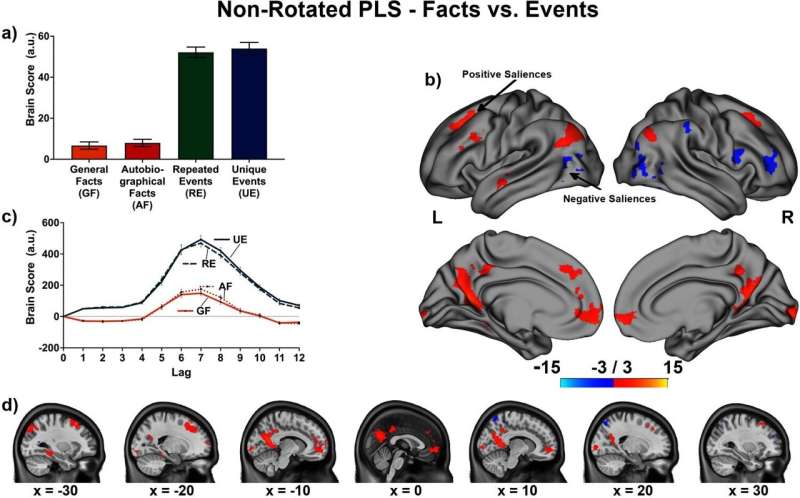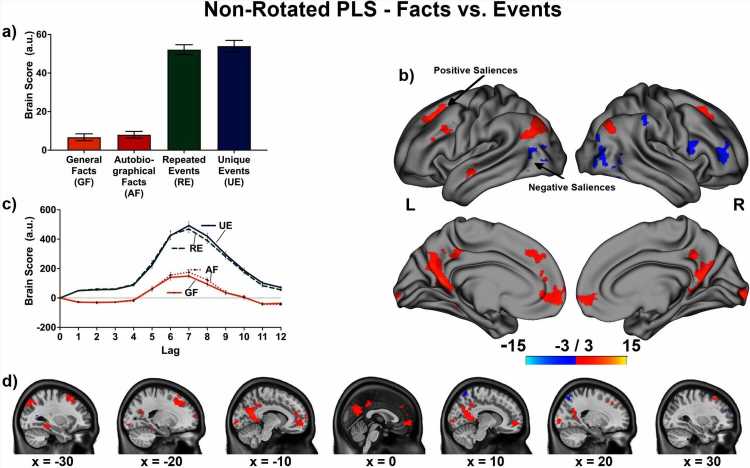
Researchers have investigated the shared and unique neural processes that underlie different types of long-term memory: general semantic, personal semantic and episodic memory.
Their study, published Nov. 21 in eLife, suggests that these memory types all use the same network of the brain, rather than relying on different areas of the brain altogether. This calls into question a previous theory that characterizes general semantic and episodic memory as two distinct systems. Instead, the authors suggest that different long-term memory types could be viewed as a spectrum, where they rely on activating the same areas of the brain at differing magnitudes.
Long-term memory can be classified into different categories. One of the most common distinctions is between semantic and episodic memory. Semantic memory refers to an individual’s non-personal, general knowledge of the world, while episodic memory concerns the recollection of contextually specific events from their personal past.
For instance, the thought “I know that a sauna is very hot, steamy, and relaxing ” is an example of a semantic memory, while “I remember winning a dare of who could stay longest in the sauna. It was a Friday night and we celebrated with a large glass of cucumber water,” is an example of episodic memory.
This distinction has been called into question in recent years. Previous research has discovered an overlap between the neural correlates of semantic and episodic memory. Neural correlates refer to the specific patterns of brain activity that are associated with the creation, storage and/or retrieval of memories and are used to help researchers understand how memories are formed and accessed in the brain. Furthermore, several types of long-term memory exist that do not neatly fit into the semantic-episodic distinction.
For example, personal semantics includes knowledge of personal facts (for example, “I have a sauna membership”) and summaries of repeated events (for example, “I always start my gym routine with stretches and good music”). As such, personal semantics exists conceptually between the boundaries of semantic and episodic memory; it is personal, like episodic memories, but detached from the context of how they were learned, like in semantic memories.
Some forms of personal semantics, such as autobiographical facts, appear to have neural correlates similar to semantic memory, while others, such as memories of repeated events, have neural correlates more similar to those of episodic memory.
“Personal semantics, despite its importance, remains an understudied area of long-term memory,” says lead author Annick Tanguay, who conducted the study at the School of Psychology, University of Ottawa, Canada, and the University of East Anglia, Norwich, U.K. (currently A postdoctoral research fellow at Vanderbilt University Medical Center, Nashville, United States).
“Few studies have directly compared personal semantics to semantic or episodic memory, and even fewer have compared different types of personal semantics to one another or to both semantic and episodic memory. With our study, we were able to do so,” added senior author Patrick Davidson, Associate Professor at the School of Psychology, University of Ottawa, Canada.
Tanguay and colleagues used a neuroimaging technique called functional magnetic resonance imaging (fMRI) to record the brain activity of 48 participants while they answered yes/no questions designed to involve either memory for general knowledge (semantic memory), unique events (episodic memory), autobiographical knowledge or memory for repeated events (two types of personal semantic memory). The team then used multivariate analysis methods to compare the participants’ brain activity across the four memory conditions.
Their results indicated that personal semantic, general semantic and episodic memory had both shared and unique neural correlates. When they contrasted four memory conditions—autobiographical facts, repeated events, general semantics, and episodic memory—with a control condition, they identified the shared neural correlates, finding that all four types of memory involved activity within several regions of the brain’s “core memory network.”
On the other hand, when they examined the four memory conditions individually, the team found that they engaged the network to a different degree of magnitude. In the large regions of the brain’s medial frontal cortex, posterior parietal cortex, and medial temporal lobes, there was a relatively small increase in activity when remembering autobiographical facts compared to general knowledge facts.
There was a further, larger increase in activity when remembering repeated events and another small increase when remembering unique events. In other areas of the brain, such as the right frontal inferior gyrus and the superior parietal lobule, the team also observed a progressive decrease in activity in the same order of memory types.
Another 106 participants made ratings on the same statements to gain additional insights into what might explain similarities and differences between memory types. In sum, the neural activity in many regions of the “core memory network” seemed to coincide with an increase in personal relevance, an increase in the visual details people perceived in their mind’s eye, and whether the memory involved a scene. The authors note, however, that caution must be exercised when drawing parallels based on data from distinct groups of participants.
“Rather than looking at a memory type overall, more work needs to be done to understand links between individual pieces of information across the spectrum of memory. For example, what does it mean for someone to know they usually do stretches at the gym and also to remember a specific instance when this happened?” comments co-author Daniela Palombo, Associate Professor at the Department of Psychology, University of British Columbia, Canada.
“Taken together, our data support a continuum perspective of long-term memory, with different memory types varying in magnitude of activation within a common network of brain regions,” concludes senior author Louis Renoult, associate professor in psychology at the School of Psychology, University of East Anglia.
“For future studies, it would be interesting to better understand the nature of the elementary components that underlie the similarities and differences between these memory types, such as the perceptual and spatial aspects of these memories and how much self-reflection they involve.”
More information:
Annick FN Tanguay et al, The shared and unique neural correlates of personal semantic, general semantic, and episodic memory, eLife (2023). DOI: 10.7554/eLife.83645
Journal information:
eLife
Source: Read Full Article
